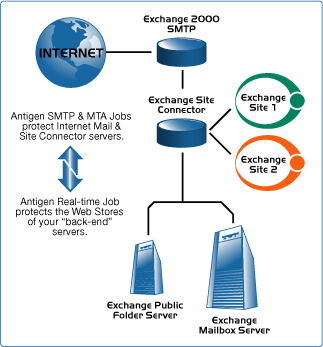Microsoft Exchange

Stop Messaging Threats to Improve Business Productivity.
E-mail is an invaluable business tool, yet it remains the number one vehicle for the spread of viruses, worms, Trojans, and other malicious code that can corrupt your company’s valuable data and networks. As malicious code writers find new ways of circumventing traditional antivirus approaches, organizations need a multi-layered strategy to keep their messaging systems secure.
Antigen® for Microsoft Exchange delivers comprehensive server-level antivirus protection with a unique, powerful multiple scan engine management approach and advanced content-filtering capabilities. Its layered protection offers the most comprehensive defense available against undesirable and malicious message traffic.
Powerful Features
Provides layered protection through Multiple Scan Engine Management to secure messaging systems
Offers sophisticated scanning options for added value and flexibility, including:
- “In-memory” scanning that minimizes impact on Exchange servers for optimum protection and efficiency
- Real-time, scheduled, and on-demand scanning of multiple storage groups and databases
- Full protection of Outlook Web Access
- SMTP and Exchange Information Store scanning for reinforced protection and performance
- MTA message scanning for all messages routed through Exchange MTA Connectors (X.400, MS Mail, CC Mail, etc.)
- Includes Microsoft-approved virus scanning API integration for Exchange 2000 and 2003
- Minimizes worm-generated spam and safeguards the Information Store through Antigen® Worm Purge
- Identifies all messages with unwanted attachments through flexible file-filtering rules
- Diverts infected attachments into a quarantine repository with Antigen® Quarantine Manager
- Automatically uploads the latest virus signatures
- Notifies administrators of virus incidents and scan events through e-mail, event logs, and SMTP pagers
- Includes customizable multiple disclaimers for outbound messages based on sender, recipient, and domain name criteria set by administrators
